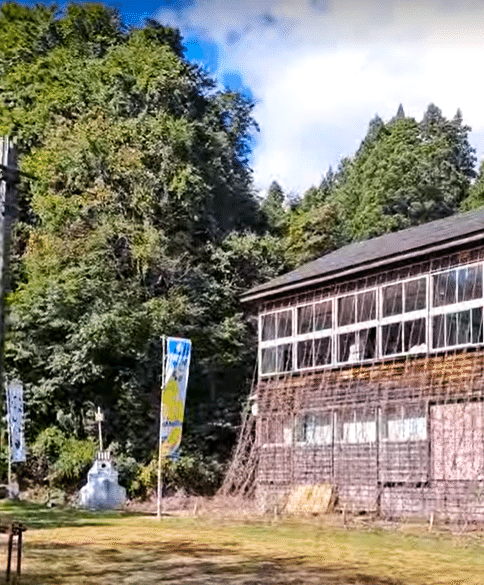
その①莇平を訪ねて~大地の芸術祭 越後妻有アートトリエンナーレ2024~
10月某日。大地の芸術祭 越後妻有アートトリエンナーレ2024の作品を見に新潟県十日町市へ日帰りで行ってきました。目的地は、新潟県十日町市の莇平(あざみひら)にある明後日新聞社文化事業部(旧莇平小学校)です。
旅のきっかけ
今回私が莇平を目指す理由は、今年度の東京藝大DOORプロジェクト8期生の方々が制作する、明後日新聞制作のお手伝いをさせて頂いたことがきっかけとなります。私を含めた3名のデザイナーで担当し、プロジェクトメンバーの方々が現地莇平で取材した記事と写真をデザイナー達がレイアウトを行い新聞として発行しています。
明後日新聞文化事業部(旧莇平小学校)で一部30円で販売中です。今後も国内外多くの人に莇平を知って、見て、体験していただきたく、継続的な活動のために購入頂けると嬉しいです。
大地の芸術祭 越後妻有アートトリエンナーレとは
2003年から始まった、3年に一度開催する世界的なアートイベント。新潟県越後妻有地域の豊かな自然や文化とアートを結びつけ、自然や農村、伝統文化といったこの土地ならではの魅力を引き出しつつ、現代アートを通じて国内外から多くの人々を引き寄せています。
東京駅からまつだい駅へ向かう
新潟へ行った日は天候も良く、東京駅で軽食を買い新幹線に飛び乗りました。
【今回使った目的地までのルート】
東京駅(新幹線)
↓
越後湯沢駅でほくほく線に乗り換え
(ワンマン普通列車。越後湯沢-直江津間)
↓
まつだい駅(タクシー乗り換え)
↓
明後日新聞社文化事業部(旧莇平小学校)
東京駅を新幹線で出発して約一時間半、あっと言う間に越後湯沢駅に到着。乗り換えのため北陸急行ほくほく線のプラットフォームに向かいました。
初めて乗った「ほくほく線」の窓の向こうには、青空と山々が広がり、まるで別世界へ引き込まれるようでした。


黄色いうさぎ「ほっくん」
まつだい駅に到着すると予約した東部タクシーさんと合流。爽やかな笑顔のドライバーIさんと挨拶を交わし、明後日新聞社を目指しました。
莇平(あざみひら)に到着
明後日新聞文化事業部(旧莇平小学校)
目的地の明後日新聞文化事業部に到着し、タクシーを降りて小学校の周辺と校庭をぶらぶら。朝露で校庭の土が柔らかく湿り、歩く度に柔らかな土の感触が足裏に伝わってきます。周囲の木々から木漏れ日が降り注ぎ、校庭の朝露をきらきらと照らしていました。
今年も沢山の花を咲かせた朝顔(明後日朝顔プロジェクト)の種とツルを観察し、次の年にもまたこの地に花が咲くことを願いながら、プロジェクトに込められた長年の思いが心に響きました。


※長くなるので次回(その②)へ続きます。
#明後日新聞文化事業部 #旧莇平小学校 #莇平
#大地の芸術祭 #越後妻有アートトリエンナーレ #越後妻有アートトリエンナーレ2024 #越後妻有 #新潟県 #新潟県四日市市 #越後湯沢 #DOORプロジェクト #東京藝大 #藝大 #アート
英語への翻訳はAI翻訳したものを載せています
ChatGPTが生成した翻訳文を載せています。不自然な部分やミスがありましたらすみません。
AI English below
One Day in October: Visiting the Echigo-Tsumari Art Triennale 2024 in Tokamachi, Niigata
I took a day trip to Tokamachi, Niigata, to see some of the artworks featured in the Echigo-Tsumari Art Triennale 2024. My destination was the Asatte Shimbun Cultural Project Office, located in Azamihira, Tokamachi, at the former Azamihira Elementary School.
Inspiration for the Trip
My motivation for visiting Azamihira stemmed from my involvement in the Tokyo University of the Arts DOOR Project, where I had the opportunity to assist with producing the Asatte Shimbun. Along with two other designers, I was responsible for the layout of articles and photos gathered by the project members during their fieldwork in Azamihira. This collaboration was then published as a newspaper, which is currently available at the Asatte Shimbun Cultural Project Office (former Azamihira Elementary School) for 30 yen per copy. We hope that many people from Japan and beyond will come to know, visit, and experience Azamihira, and we appreciate any support through purchasing this publication to help sustain these activities.
About the Echigo-Tsumari Art Triennale
Started in 2003, this triennial global art event takes place every three years and highlights the rich natural and cultural heritage of the Echigo-Tsumari region of Niigata. By integrating contemporary art with the local landscape, rural lifestyle, and traditional culture, the event attracts people from all over Japan and abroad.
Getting from Tokyo to Matsudai Station
The weather was lovely on the day of my trip. I bought a light snack at Tokyo Station and boarded the shinkansen.
Here’s the route I took to my destination:
Tokyo Station (Shinkansen)
Transfer at Echigo-Yuzawa Station to the Hokuhoku Line (local one-man train operating between Echigo-Yuzawa and Naoetsu)
Arrive at Matsudai Station (switch to a taxi)
Head to the Asatte Shimbun Cultural Project Office (former Azamihira Elementary School)
It took about an hour and a half to reach Echigo-Yuzawa Station by shinkansen, and I was quickly on my way to the Hokuhoku Line platform. It was my first time on the Hokuhoku Line, and the train was nearly full. Luckily, I got a window seat, and outside, I could see traces of summer lingering in the clear blue skies and surrounding mountains.
Upon arriving at Matsudai Station, I met up with a reserved taxi from Toubu Taxi. I greeted the friendly driver, Mr. I, and we headed toward the Asatte Shimbun.
Arrival in Azamihira (Asatte Shimbun Cultural Project Office, former Azamihira Elementary School)
When we arrived at the Asatte Shimbun Cultural Project Office, I took a walk around the former elementary school and its grounds. The morning dew softened the earth, and I felt a gentle connection to the soil with each step. Sunlight filtered through the trees, making the morning dew on the playground glisten.
I also took a moment to observe the morning glories (part of the Asatte Morning Glory Project), imagining that the seeds and vines would bloom somewhere else in Japan next year. Reflecting on the long-standing efforts to keep this project alive stirred my emotions.
この記事が参加している募集
この記事が気に入ったらサポートをしてみませんか?
